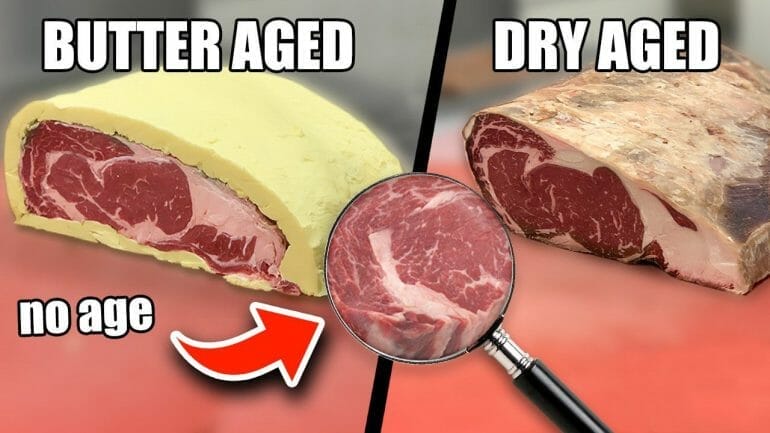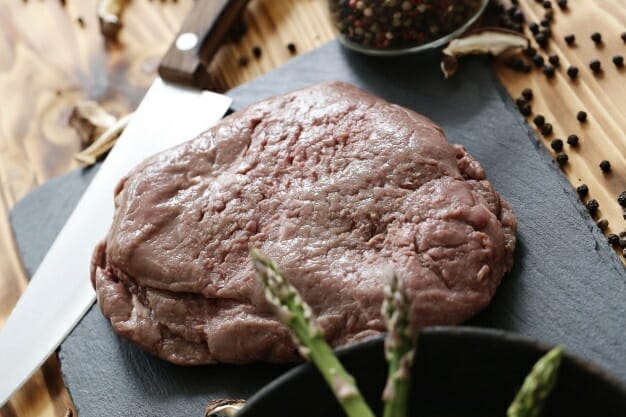Butter aging is a unique and innovative technique used to enhance the flavor and tenderness of steak. By incorporating butter into the aging process, the steak undergoes a transformative journey that results in a melt-in-your-mouth dining experience.
This process involves placing the steak in a vacuum-sealed bag, along with generous amounts of butter, and allowing it to age in a controlled environment for an extended period. As the steak ages, it absorbs the rich flavors and moisture from the butter, resulting in a succulent and flavorful piece of meat.
Butter aging creates a beautiful marbling effect within the steak, enhancing its tenderness and juiciness. The butter also adds a creamy and slightly nutty flavor, elevating the taste profile of the steak to new heights.
When it comes to butter aging, it’s important to use high-quality butter to ensure the best results. Additionally, the aging time can vary depending on personal preference, with some opting for a few days and others extending it to several weeks.
This unique method has gained popularity among steak enthusiasts and professional chefs, as it offers a luxurious and indulgent twist to the traditional aging process. So, if you’re looking to elevate your steak game and experience a truly remarkable dining experience, consider trying the butter aging technique.

Dry Aging vs. Wet Aging: Which Method is Better?
When it comes to aging meat, two methods dominate the industry: dry aging and wet aging. Both techniques have their proponents, but which one is truly better? In this section, we will delve into the differences between dry aging and wet aging and examine their respective advantages and disadvantages.
Dry Aging
Dry aging is the traditional method of aging meat, dating back centuries. In this process, whole cuts of meat are placed in a controlled environment with specific temperature and humidity levels. The meat is left to age for an extended period, typically weeks or even months.
One of the key benefits of dry aging is the intensification of flavors. As the meat ages, enzymes naturally break down muscle fibers, resulting in a more tender and flavorful end product. Additionally, the drying process causes the meat to lose moisture, concentrating its flavors even further.
Another advantage of dry aging is the formation of a caramelized crust on the meat’s surface, known as the “pellicle.” This crust not only adds depth of flavor but also enhances the texture, creating a satisfying contrast between the tender interior and the crispy exterior.
However, dry aging does have its drawbacks. The process requires a dedicated and controlled environment, which can be costly and time-consuming. Moreover, the loss of moisture during dry aging means that the final yield of the meat is significantly reduced.
Wet Aging
Wet aging, on the other hand, is a relatively newer method that has gained popularity in recent years. In this technique, vacuum-sealed cuts of meat are aged in their own juices, typically for a shorter duration compared to dry aging.
One of the main advantages of wet aging is its convenience. Unlike dry aging, wet aging does not require any specialized equipment or storage conditions. The vacuum-sealed packaging ensures that the meat remains moist and prevents any flavor loss. Additionally, since wet aging does not result in moisture loss, the yield of the meat is higher compared to dry aging.
However, some argue that wet aging can result in a less intense flavor compared to dry aging. Without the evaporation and enzyme breakdown that occurs during dry aging, the flavors may not be as concentrated. Additionally, the lack of a caramelized crust means that the texture of the meat may be slightly different.
Which Method is Better?
Ultimately, whether dry aging or wet aging is better comes down to personal preference. Dry aging offers a more intense flavor and unique texture but requires specialized conditions and results in a lower yield. Wet aging, on the other hand, is more convenient and yields a juicier end product, but the flavors may be less concentrated.
In summary, both dry aging and wet aging have their merits and drawbacks. It is up to you to decide which method aligns with your taste preferences, budget, and available resources. Regardless of the method chosen, aging meat is a time-honored technique that enhances the flavor and tenderness of the final product.

How to Properly Dry Age a Steak at Home
If you’re a steak lover, you’ve probably heard about the deliciousness of dry-aged steaks. Dry aging is a process that involves allowing a cut of beef to rest in a controlled, refrigerated environment for an extended period. This process helps enhance the flavor and tenderness of the meat, resulting in a melt-in-your-mouth experience. While you may think that dry aging is only for high-end restaurants or butcher shops, you’ll be delighted to know that you can also dry age a steak at home. In this section, we will guide you through the steps of properly dry aging a steak in the comfort of your own kitchen.
Choose the Right Cut of Meat
The first and most crucial step in dry aging a steak at home is selecting the right cut of meat. Not all cuts are suitable for dry aging, so it’s essential to choose a good-quality piece of beef. The best cuts for dry aging are typically bone-in cuts, such as ribeye or striploin, as they have a good amount of fat marbling and are known for their flavor and tenderness. Make sure to choose a well-marbled piece of meat with a thick fat cap.
Prepping the Meat
Once you’ve chosen the perfect cut of meat, it’s time to prepare it for the dry aging process. Start by patting the steak dry with paper towels to remove any excess moisture. This step is important as moisture can hinder the dry aging process and potentially lead to bacterial growth. Next, place the steak on a wire rack set inside a baking tray. The wire rack allows for better airflow around the meat and helps prevent the steak from sitting in its juices.
Creating the Dry Aging Environment
Creating the ideal environment for dry aging is crucial to achieving the best results. You’ll need a dedicated space in your refrigerator for this process. It’s recommended to use a mini-fridge or a dedicated aging fridge if possible. Clear out any other food items from the fridge to ensure the steak isn’t affected by any odors. Place the tray with the steak on the bottom shelf, leaving enough space around it for air circulation. Ideally, the temperature should be around 34°F to 38°F (1°C to 3°C), and the humidity should be approximately 70%.
Patience is Key
Dry aging a steak requires patience as it’s a slow process. The recommended aging time is around 21 to 45 days, depending on your desired level of flavor and tenderness. During this time, it’s essential to regularly check on the steak to ensure there are no signs of spoilage or mold growth. If you notice any discoloration or off-putting smells, it’s best to discard the steak immediately. However, if everything looks and smells fine, continue to monitor the aging process.
Trimming and Cooking
After the desired aging period, it’s time to trim and cook your dry-aged steak. Carefully remove the steak from the aging environment and inspect it for any residual mold or off flavors. Trim off any dried-out or moldy parts before cooking. Dry-aged steaks tend to have a dark, firm outer layer (called the pellicle), which should be removed before cooking. Once trimmed, you can either grill, pan-sear, or broil the steak to your preferred level of doneness.
In Summary
Dry aging a steak at home is a rewarding experience that can elevate the flavor and tenderness of your meat. By selecting the right cut, prepping the meat, creating the ideal aging environment, exercising patience, and trimming before cooking, you can enjoy the deliciousness of a perfectly dry-aged steak in the comfort of your own home. Remember to follow food safety guidelines and discard any steak that shows signs of spoilage. Happy dry aging and bon appétit!

Tips for Wet Aging Steaks
In this section, we will discuss some valuable tips for wet aging steaks. Wet aging is a process used in the meat industry to enhance the tenderness and flavor of steaks. Unlike dry aging, wet aging involves storing the meat in vacuum-sealed bags, allowing it to age in its natural juices. Let’s explore some tips to achieve the best results when wet aging steaks.
1. Choose the Right Cuts
When wet aging steaks, it is crucial to choose the right cuts of meat. Opt for well-marbled cuts such as ribeye, striploin, or tenderloin, as they tend to benefit the most from the tenderizing effects of wet aging.
2. Proper Packaging
Ensure that the steaks are properly packaged for wet aging. Vacuum-sealed bags are the ideal choice, as they prevent the meat from coming into contact with air, reducing the risk of spoilage. Make sure to remove any excess air from the bag before sealing it.
3. Temperature Control
Maintaining proper temperature control is essential during the wet aging process. Store the steaks in a refrigerator set at temperatures between 32°F and 36°F (0°C and 2°C). Consistent temperature is crucial to prevent bacterial growth and ensure the desired aging results.
4. Aging Duration
The duration of wet aging can vary depending on personal preference and the desired level of tenderness. While the minimum recommended aging period is around 14 days, some individuals prefer longer aging periods to achieve maximum tenderness and flavor. Experimentation is key to finding the sweet spot for your preference.
5. Handling with Care
During the wet aging process, it is important to handle the steaks with care to avoid any unnecessary damage. Avoid puncturing the vacuum-sealed bags or exposing the meat to air, as it can lead to spoilage and compromise the aging process.
6. Quality Check
Regularly inspect the steaks during the aging period to ensure they are in good condition. Look for any signs of spoilage, such as unpleasant odors, discoloration, or slimy texture. If you notice any of these signs, discard the steak immediately.
7. Patience is Key
Wet aging is a process that requires patience. The meat needs time to develop its flavors and tenderize. Avoid rushing the process and allow the steaks to age for the desired duration to achieve the best results.
8. Cooking Methods
When it comes to cooking wet-aged steaks, various methods can be employed. Grilling, pan-searing, or broiling are popular options that help accentuate the flavor and tenderness achieved through the wet aging process.
In summary, wet aging steaks can significantly enhance their tenderness and flavor. By selecting the right cuts, properly packaging the meat, maintaining temperature control, and exercising patience, you can achieve delicious and tender steaks that will satisfy even the most discerning palates.
Understanding the effects of aging on steak flavor and tenderness
When it comes to enjoying a delicious steak, flavor and tenderness are two key factors that can make or break the dining experience. One method that has been used for centuries to enhance these qualities is the process of aging the steak. Aging refers to the controlled decomposition of meat enzymes and the breakdown of connective tissues, resulting in improved flavor and tenderness. In this section, we will dive deeper into the effects of aging on steak and why it is a crucial step in producing a high-quality steak.
The two main types of steak aging
There are two main methods of steak aging: dry aging and wet aging. Both methods involve allowing the meat to rest under specific conditions, but they differ in terms of the environment in which the aging takes place.
Dry aging: Dry aging is a traditional method where the steak is hung and exposed to air in a temperature and humidity-controlled environment. This process allows the meat to naturally tenderize and develop a more concentrated flavor. The outer layers of the steak form a dry crust, which is trimmed off before cooking.
Wet aging: Wet aging, on the other hand, involves vacuum-sealing the steak in plastic and allowing it to age in its own juices. This method is more common in commercial settings as it requires less time and space compared to dry aging. Wet aging helps to retain moisture and can result in a more tender steak, although the flavor development may not be as pronounced as in dry-aged steaks.
The science behind aging
Both dry and wet aging rely on the action of enzymes and the breakdown of connective tissues to improve the flavor and tenderness of the steak.
During the aging process, enzymes naturally present in the meat break down proteins, making them more tender. These enzymes, such as cathepsin and calpain, act on the muscle fibers, breaking down the connective tissues and making the meat more tender. The longer the aging period, the more time these enzymes have to work, resulting in a more tender steak.
Additionally, aging allows for the development of flavor compounds. As the meat ages, the breakdown of fats and proteins generates new compounds that contribute to the complex flavors found in well-aged steaks. Dry aging, in particular, enhances flavor through the process of oxidation and evaporation, further concentrating the flavors.
The benefits of aging
Aging steaks not only improves their flavor and tenderness but also offers several other benefits:
- Intensified flavor: The aging process allows the natural flavors of the steak to develop and become more pronounced, resulting in a richer and more complex taste.
- Tenderness: Enzymatic breakdown of connective tissues leads to increased tenderness, making the steak more enjoyable to eat.
- Moisture retention: Wet aging helps retain moisture within the meat, preventing it from drying out during cooking.
- Concentrated flavors: Dry aging concentrates the flavors by reducing moisture content and intensifying the overall taste.
Choosing the right aging method
Deciding between dry aging and wet aging depends on personal preference and availability. Dry-aged steaks are known for their pronounced flavors and tenderness, but they can be more expensive and require specialized facilities. Wet-aged steaks, on the other hand, are more readily available and offer good tenderness, although with slightly less intense flavor development.
In summary, aging plays a crucial role in enhancing the flavor and tenderness of steaks. Whether through the traditional dry aging method or the more convenient wet aging process, the controlled decomposition of enzymes and the breakdown of connective tissues result in a superior dining experience. So, the next time you savor a perfectly cooked steak, remember the time and effort that went into its aging process to make it truly exceptional.
FAQs
1. How to butter age a steak?
Butter aging is a method where you coat a steak with a layer of butter to enhance its tenderness and flavor. To butter age a steak, pat the steak dry, let it come to room temperature, season with salt and pepper, and then coat all sides with softened butter. Place the steak in the refrigerator for at least 24 hours before cooking.
2. How long should I butter age a steak?
For best results, you should butter age a steak for at least 24 hours. This allows enough time for the butter to penetrate the meat, tenderizing and flavoring it. However, you can also extend the butter aging time to 48-72 hours for even more tenderness and flavor development.
3. Can I butter age any cut of steak?
While butter aging can be done with various cuts of steak, it is typically recommended for thicker and more marbled cuts, such as ribeye or New York strip. These cuts tend to benefit the most from the butter aging process, resulting in a more tender and flavorful steak.
Conclusion:
In conclusion, butter age is a fantastic technique to enhance the flavor and tenderness of a steak. By allowing the steak to rest in a mixture of butter and herbs, it absorbs the rich flavors and results in a more succulent and buttery taste. The process of butter aging not only tenderizes the meat but also adds an extra layer of richness to every bite, making it a perfect choice for steak enthusiasts. Whether you are grilling, pan-searing, or broiling, butter aging can take your steak to a whole new level of deliciousness. So, why not try this unique and mouthwatering method for your next steak night?
